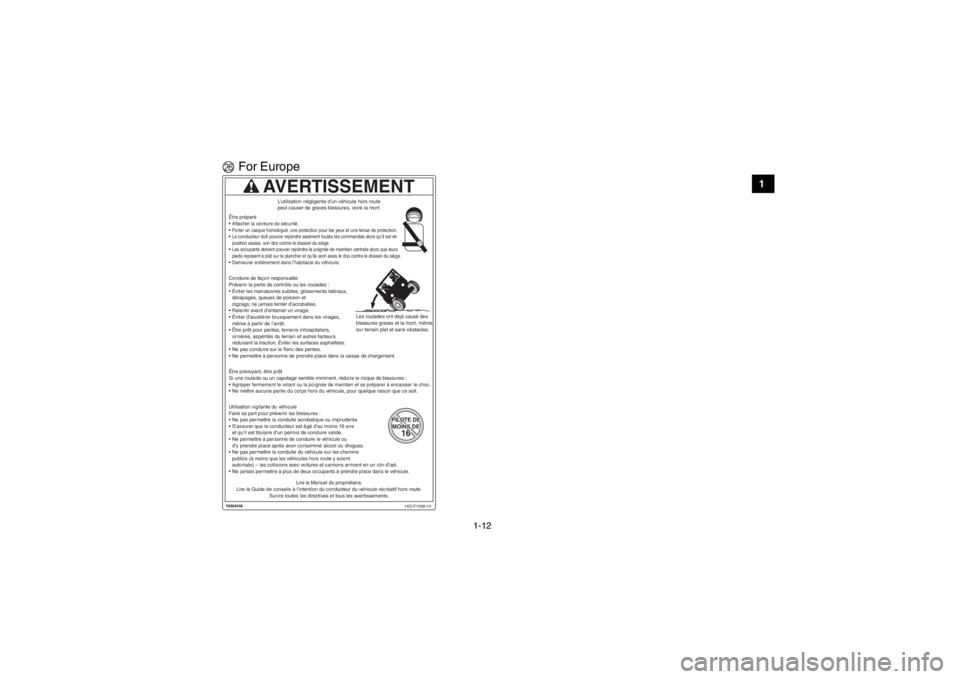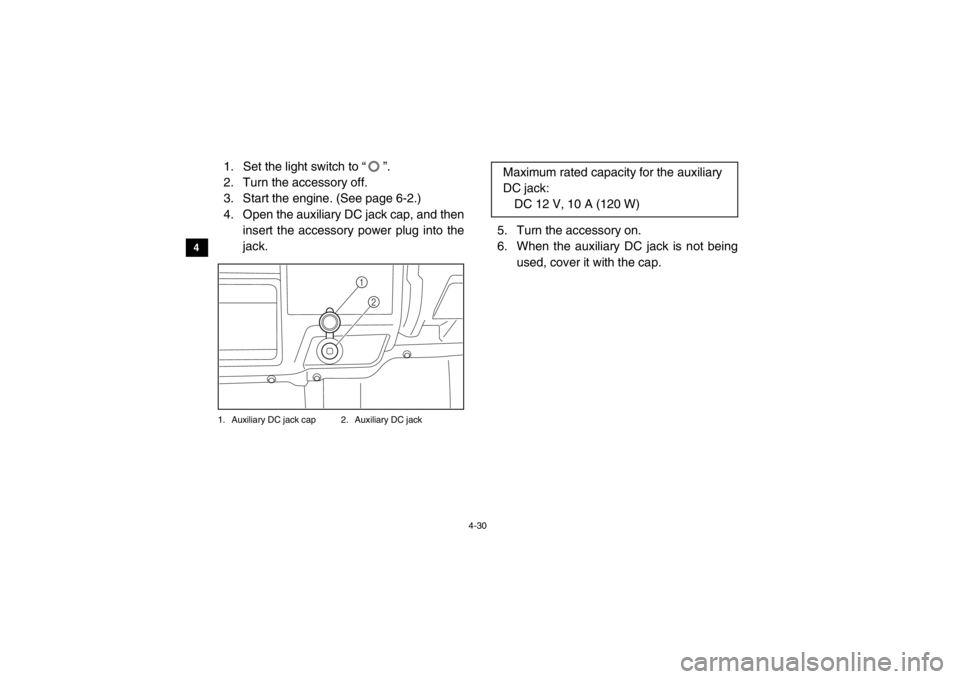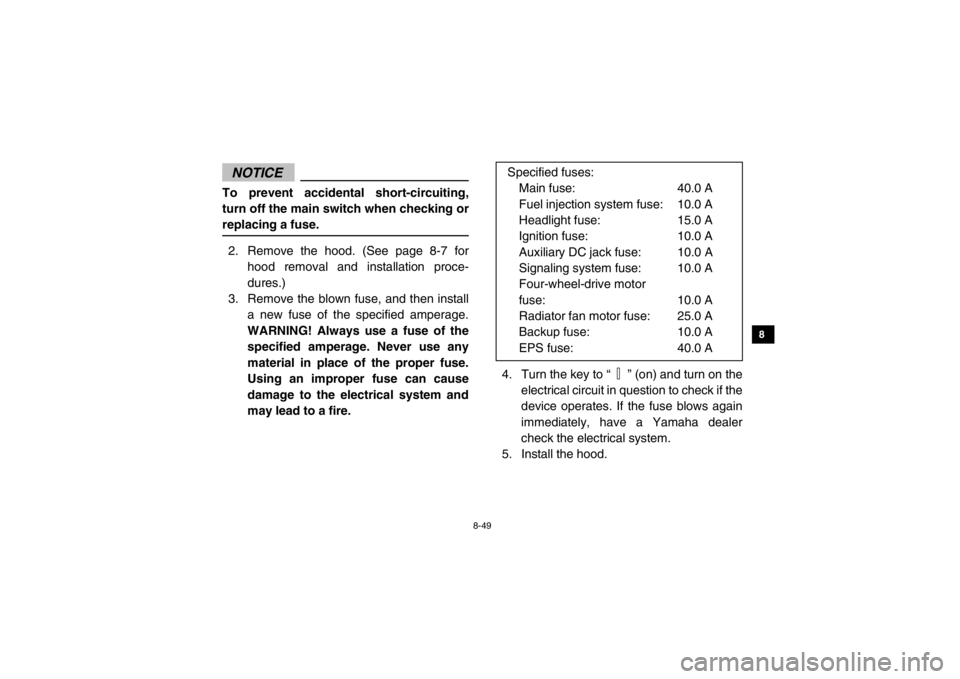2015 YAMAHA VIKING AUX
[x] Cancel search: AUXPage 6 of 182

EVU00050
CONTENTS
LOCATION OF THE WARNING
AND SPECIFICATION LABELS ....... 1-1
SAFETY INFORMATION.................. 2-1
DESCRIPTION ................................. 3-1
INSTRUMENT AND CONTROL
FUNCTIONS ..................................... 4-1Main switch ...................................... 4-1
Indicator lights and warning lights ... 4-2
Multi-function meter unit .................. 4-6
Light switch .................................... 4-12
On-Command drive knob
“2WD/4WD/DIFF LOCK” ............. 4-13
Horn switch .................................... 4-14
Accelerator pedal .......................... 4-15
Brake pedal ................................... 4-15
Parking brake lever ....................... 4-16
Drive select lever ........................... 4-16
Fuel tank cap ................................. 4-17
1234
Doors..............................................4-17
Seats ..............................................4-18
Adjusting the driver seat position...4-19
Seat belts .......................................4-20
Glove compartment .......................4-21
Storage compartments ..................4-22
Cup holders....................................4-24
Cargo bed ......................................4-25
The front and rear shock absorber
assemblies ...................................4-28
Trailer hitch bracket and
receiver ........................................4-29
Auxiliary DC jack ............................4-29
FOR YOUR SAFETY –
PRE-OPERATION CHECKS ............5-1 Front and rear brakes ......................5-3
Fuel ..................................................5-4
Engine oil .........................................5-6
Coolant.............................................5-6
Final gear oil ....................................5-7
Differential gear oil ...........................5-7
Accelerator pedal .............................5-7
5
1XP7C_EE.book Page 1 Monday, June 9, 2014 5:17 PM
Page 21 of 182

1-12
1
2
3
4
5
6
7
8
9
10
11
12
13
14
PFor EuropeYAMAHA
1XD-F1568-10
AVERTISSEMENT
PILOTE DEPILOTE DEMOINS DEMOINS DE1616PILOTE DE
MOINS DE16
Lire le Manuel du propriétaire.
Lire le Guide de conseils à l’intention du conducteur du véhicule récréatif hors route. Suivre toutes les directives et tous les avertissements.L’utilisation négligente d’un véhicule hors route
peut causer de graves blessures, voire la mort.
Les roulades ont déjà causé des
blessures graves et la mort, même
sur terrain plat et sans obstacles.
Utilisation vigilante du véhicule
Faire sa part pour prévenir les blessures : Ne pas permettre la conduite acrobatique ou imprudente.
S’assurer que le conducteur est âgé d’au moins 16 ans
et qu’il est titulaire d’un permis de conduire valide.
Ne permettre à personne de conduire le véhicule ou
d’y prendre place après avoir consommé alcool ou drogues.
Ne pas permettre la conduite du véhicule sur les chemins
publics (à moins que les véhicules hors route y soient
autorisés) – les collisions avec voitures et camions arrivent en un clin d’œil.
Ne jamais permettre à plus de deux occupants à prendre place dans le véhicule.
Être préparé
Attacher la ceinture de sécurité.Porter un casque homologué, une protection pour les yeux et une tenue de protection.Le conducteur doit pouvoir rejoindre aisément toutes les commandes alors qu’il est en
position assise, son dos contre le dossier du siège.Les occupants doivent pouvoir rejoindre la poignée de maintien centrale alors que leurs
pieds reposent à plat sur le plancher et qu’ils sont assis le dos \
contre le dossier du siège.Demeurer entièrement dans l’habitacle du véhicule.
Conduire de façon responsable
Prévenir la perte de contrôle ou les roulades :
Éviter les manœuvres subites, glissements latéraux,
dérapages, queues de poisson et
zigzags; ne jamais tenter d’acrobaties.
Ralentir avant d’entamer un virage.
Éviter d’accélérer brusquement dans les virages,
même à partir de l’arrêt.
Être prêt pour pentes, terrains inhospitaliers,
ornières, aspérités du terrain et autres facteurs
réduisant la traction. Éviter les surfaces asphaltées.
Ne pas conduire sur le flanc des pentes.
Ne permettre à personne de prendre place dans la caisse de chargement.
Être prévoyant, être prêt
Si une roulade ou un capotage semble imminent, réduire le risque de blessures :Agripper fermement le volant ou la poignée de maintien et se préparer à encaisser le c\
hoc.
Ne mettre aucune partie du corps hors du véhicule, pour quelque raison que ce soit.
1XP7C_EE.book Page 12 Monday, June 9, 2014 5:17 PM
Page 32 of 182

3-2
3
4
5
6
7
8
9
10
11
12
13
14
27. Light switch
28. On-Command drive knob
29. Steering wheel
30. Main switch
31. Parking brake lever
32. Helmet indicator light
33. Seat belt indicator light
34. Drive select lever
35. Horn switch
36. Accelerator pedal
37. Brake pedal 38. Multi-function meter unit
39. Passenger handhold
40. Glove compartment
41. Auxiliary DC jack
42. Storage compartment
The vehicle you have purchased may differ
slightly from those shown in the figures of this
manual.
[
Z
R
S
T
U
Y
Q
VWX
b
^
\
]a
1XP7C_EE.book Page 2 Monday, June 9, 2014 5:17 PM
Page 61 of 182

4-29
1
2
34
5
6
7
8
9
10
11
12
13
14
EVU00370Trailer hitch bracket and receiverThis vehicle is equipped with a trailer hitch
bracket and a 5 cm (2 in) receiver for a stan-
dard trailer hitch. Trailer towing equipment
can be obtained at a Yamaha dealer. (See
page 6-8 for precaution information.)1. Trailer hitch bracket 2. Receiver
EVU00380Auxiliary DC jackThe auxiliary DC jack is located at the right
side of the storage compartment under the
multi-function meter. The auxiliary DC jack
can be used for suitable work lights, radios,
etc. The auxiliary DC jack should only be used
when the engine is running and the headlights
are turned off.NOTICE●
Do not use accessories requiring
more than the stated maximum capac-
ity. Doing so may overload the circuit
and cause the fuse to blow.
●
If accessories are used without the
engine running, the battery may dis-
charge.
●
Do not use an automotive cigarette
lighter or other accessories with a
plug that gets hot, because the jack
can be damaged.
2
1
1XP7C_EE.book Page 29 Monday, June 9, 2014 5:17 PM
Page 62 of 182

4-30
4
5
6
7
8
9
10
11
12
13
14
1. Set the light switch to “ ”.
2. Turn the accessory off.
3. Start the engine. (See page 6-2.)
4. Open the auxiliary DC jack cap, and then insert the accessory power plug into the
jack.1. Auxiliary DC jack cap 2. Auxiliary DC jack
5. Turn the accessory on.
6. When the auxiliary DC jack is not being used, cover it with the cap.
2
1
Maximum rated capacity for the auxiliary
DC jack:DC 12 V, 10 A (120 W)
1XP7C_EE.book Page 30 Monday, June 9, 2014 5:17 PM
Page 158 of 182

8-48
8
9
10
11
12
13
14
5B410023Fuse replacementThe main fuse, the fuel injection system fuse,
the EPS fuse, and the fuse box are located
under the hood.1. Fuse box 2. Main fuse
3. EPS fuse
4. Fuel injection system fuse
5. Fuel injection system spare fuse 1. Backup fuse “BACK UP” (for clock)
2. Ignition fuse “IGNITION”
3. Four-wheel-drive motor fuse “DIFF”
4. Auxiliary DC jack fuse “TERMINAL”
5. Signaling system fuse “SIGNAL”
6. Headlight fuse “HEAD”
7. Spare fuse (
× 3)
8. Radiator fan motor fuse “FAN”
If a fuse is blown, replace it as follows.
1. Turn the key to “ ” (off) and turn off the
electrical circuit in question.
1 3
2
4
5
1
2
3
4
5
6
8
7
7
1XP7C_EE.book Page 48 Monday, June 9, 2014 5:17 PM
Page 159 of 182

8-49
1
2
3
4
5
6
78
9
10
11
12
13
14
NOTICETo prevent accidental short-circuiting,
turn off the main switch when checking or
replacing a fuse.2. Remove the hood. (See page 8-7 forhood removal and installation proce-
dures.)
3. Remove the blown fuse, and then install a new fuse of the specified amperage.
WARNING! Always use a fuse of the specified amperage. Never use any
material in place of the proper fuse.
Using an improper fuse can cause
damage to the electrical system and
may lead to a fire. 4. Turn the key to “ ” (on) and turn on the
electrical circuit in question to check if the
device operates. If the fuse blows again
immediately, have a Yamaha dealer
check the electrical system.
5. Install the hood. Specified fuses:
Main fuse: 40.0 A
Fuel injection system fuse: 10.0 A
Headlight fuse: 15.0 A
Ignition fuse: 10.0 A
Auxiliary DC jack fuse: 10.0 A
Signaling system fuse: 10.0 A
Four-wheel-drive motor
fuse: 10.0 A
Radiator fan motor fuse: 25.0 A
Backup fuse: 10.0 A
EPS fuse: 40.0 A
1XP7C_EE.book Page 49 Monday, June 9, 2014 5:17 PM
Page 177 of 182

10-5
1
2
3
4
5
6
7
8
910
11
12
13
14
Bulb voltage, wattage
× quantity:
Headlight:
12 V, 35.0/35.0 W × 2
Tail/brake light:
12 V, 5.0/21.0 W × 2
Neutral indicator light: LED
Reverse indicator light: LED
Coolant temperature warning light:
LED
Engine trouble warning light: LED
Parking brake indicator light: LED
On-Command four-wheel-drive/differential gear lock indica-
tor: LCD
High-range indicator light:
LED
Low-range indicator light: LED
Differential gear lock indicator light: LED
EPS warning light:
LED
Helmet/Seat belt indicator light: 14 V, 0.85 W × 2Fuses:Main fuse:
40.0 A
Fuel injection system fuse: 10.0 A EPS fuse:
40.0 A
Headlight fuse: 15.0 A
Signaling system fuse:
10.0 A
Ignition fuse: 10.0 A
Auxiliary DC jack fuse: 10.0 A
Backup fuse:
10.0 A
Four-wheel-drive motor fuse: 10.0 A
Radiator fan motor fuse: 25.0 A
For Europe only
The figures quoted are emission levels and
are not necessarily safe working levels. Whilst
there is a correlation between the emission
and exposure levels, this cannot be used reli-
ably to determine whether or not further pre-
cautions are required.
Factors that influence the actual level of expo-
sure of work-force include the characteristics
of the work room, the other sources of noise,
etc. i.e. the number of machines and other ad-
1XP7C_EE.book Page 5 Monday, June 9, 2014 5:17 PM